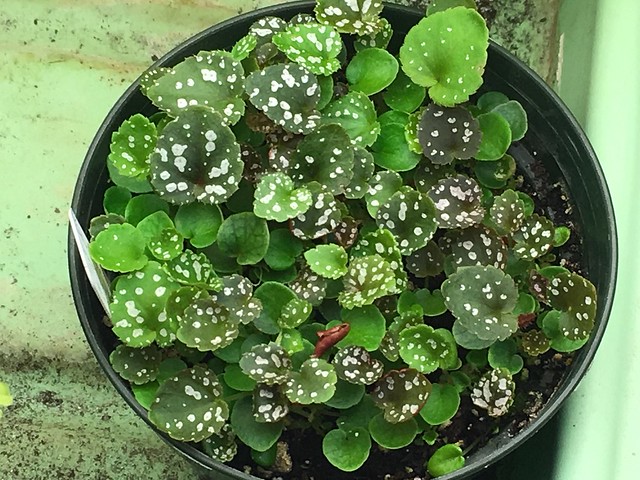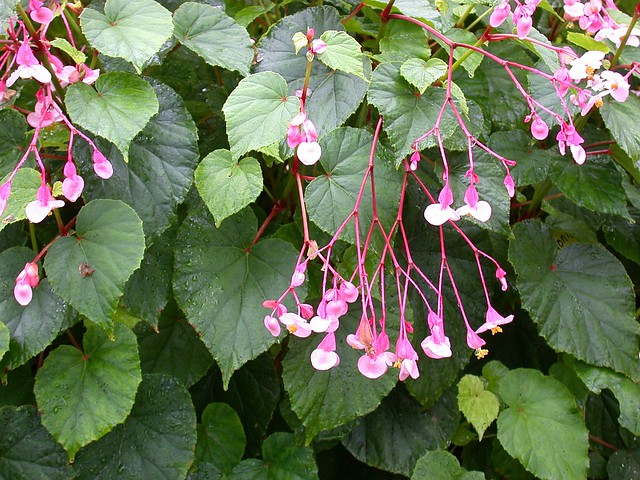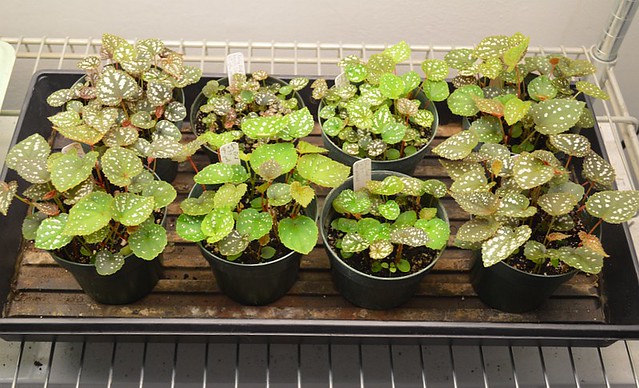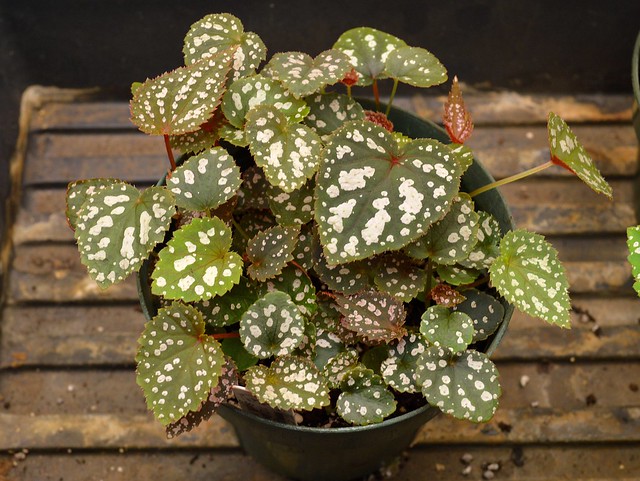
Begonia grandis seedlings, early January
This blog post was inspired by plant breeder Joseph Tychonievich, writing for The Garden Professors blog a few weeks ago. In "Blast from my petunia past", Joseph showed the wide range of seedlings he got in the F2 generations of two different interspecific crosses he had made in the genus Petunia. In reply to my comment about the importance of growing out large numbers of seedlings he said, "I totally agree — I selected the 9 flowers in each image as the most extreme forms from populations of several hundred seedlings. If you just grew a couple dozen seedling from each of these crosses you’d miss out on a lot of cool things. Breeding is, a lot of the time, a numbers game. The more you can grow, the more cool things you’ll find."
One of the biggest mistakes an amateur plant breeder can make is not growing out enough seedlings, and I've been guilty of this myself. The F1 generation from a cross between two species is generally (not always!) fairly uniform, but the greater the difference between the two parents, the wider the range of variation you'll get in the F2. Even the F1 generation between two species can produce some subtle but interesting variation among the siblings, especially if the parents are wild-collected and have a good degree of natural but hidden heterozygosity (as wild populations often do). The more seedlings you grow, the more variation you’ll see, the better your choices to select from will be, and the greater the likelihood of getting those one or two rare but really fabulous outliers.

Begonia grandis: beautiful, but can we do better?
Building on 30 years of experience with breeding gesneriads, my latest plant breeding involves the genus Begonia. My goal is to produce hardy begonias that have more ornamental foliage than the common Begonia grandis. This handsome species, quite hardy but one of the more modest in a genus known for flashy foliage, has been in cultivation for centuries, badly inbred, with a very limited range of variation. Recent wild collections of this species have introduced some new genetics and opened up new possibilities for breeding. I'm working with a couple of these new collections and this is where it starts getting fun.

B. grandis 'Nanjiang Silver', a new wild collection
Even though such crosses are intraspecific (within the same species), the wild collections differ enough that crossing them with each other and with the old cultivated forms should produce some very interesting plants. I'm determined to get something good, something worth naming, so this time around I'm growing several hundred seedlings from the seeds I collected last year. The seedlings in the photo way up at the top represent just one of these sowings. Before you get too excited, it's normal for B. grandis seedlings to have silver spotting, and it's normal for them to lose it as the plants mature. One of the new wild collections, 'Nanjiang Silver', is a notable exception and may be the key to the ornamental foliage I'm looking for.

Begonia grandis seedlings, late January
I'm growing seedlings from several different crosses and selfings, and every single one of them is different. This is where it becomes the numbers game Joseph referred to. Somewhere in there is that one great seedling with just the right combination of genes, that fabulous plant that will knock everybody's socks off; the problem is finding it. Ideally, I would grow several thousand seedlings to maturity but at some point space becomes an issue. I've already culled (discarded) several hundred seedlings, keeping only the biggest and most vigorous seedlings to grow to the next stage.
As the seedlings grow and begin to crowd each other, thinning them out by culling the smallest, slowest, and weakest seedlings will only help so much. Shortly after taking that top photo, I separated and repotted the seedlings. In the photo directly above, they're occupying the left three pots in the back row. (The other pots of seedlings are from two other B. grandis crosses.) I sorted them by size and by leaf color, giving them room to grow, but just a couple of weeks later they're already crowded again. Here's a closeup of the single pot at the upper left:

Closeup
My goal is to produce plant with that pretty silver spotting on mature plants, so as the plants grow, I discard any that lose their silver spots. The problem for any hobbyist breeder is finding the room to grow all these seedlings; with extremely limited growing space I have to be ruthless in discarding any that aren't what I'm looking for. With any luck, by the time spring comes and it's warm enough to plant outdoors, I'll be down to a few good-looking plants that still have silver spots on the leaves. But that's not the end of it because it's not just about finding the prettiest plant. 'Nanjiang Silver' is already a very pretty plant, but performs poorly in my climate because it lacks heat tolerance and vigor. The more seedlings I can grow, the more likely I am to find that one seedling that's not just attractively marked but also vigorous and heat-tolerant. Come spring, I'll plant the remaining seedlings out in the garden, and then I'll evaluate them through at least two growing seasons. In a couple of years maybe, just maybe, I'll have something that will knock your socks off.

Very well said... Useful information for all hybridizers!
ReplyDelete"The more seedlings you grow, the more variation you’ll see, the better your choices to select from will be, and the greater the likelihood of getting those one or two rare but really fabulous outliers."
ReplyDeleteReally well said! One of my mantras is "progress is a function of difference".
Out of all the plants... I think that the orchid family is the poster child for the numbers game. A single seed pod can contain around a million seeds! Given that no two seeds are going to be exactly alike... that's quite a bit of difference. I'm pretty sure that the orchid family's success is in large part due to how well it plays the numbers game. Although I have yet to find a single scientific paper that has made the same argument.
Recently I started growing reed-stem Epidendrums from seed. Last year I learned just how quick and easy they grow from seed. No flasking required. Epidendrum secundum actually has the largest seeds in the orchid family. So I'm guessing that they have enough nutrients to germinate on their own. I'm really curious what the evolutionary explanation is.
The drawback is that it takes a few years before the seedlings are blooming size. I'm hoping to cross them with some Barkeria species which are relatively "precocious". Then a lot more progress could be made in a lot less time.
Reed-stem Epis are relatively cold tolerant... but I'm guessing that your winters would fry them. But if you ever want to try growing some from seed just for the heck of it... then I'll be happy to share some seeds with you.
Ok - here's what I want to know: When can I start buying your fabulous plants? :o)
ReplyDeleteI'm with C.M! Fascinating stuff!
ReplyDeleteI am a professional plant breeder and read you column with interest , there is no way around large number of seedlings but during the course of the work certain parameters can be established to eliminate those that are of no interest , such as heat tolerance , cold tolerance , salt tolerance and so on , many times these selection pressures can be implemented just as soon as the seedlings germinate , those that make it go on to round two. Bear in mind that most real changes are recessive and show up in the F2 generation so you are faced with growing out some selections and letting them cross amongst themselves or back cross to the parent with the traits you want to pass on , this eliminates some of the recessive traits to that they become more evident . It requires numbers and there is no way around it . Again in the F2's ruthless trials that push the limits get you to where you want to be , too little too late just prolongs the throng of seedlings cluttering up all available space , some seedling along the way have to die . Above all do not get your spouse or close friend to help select as they will be inclined to keep everything . By design it has to be a big burn pile at the end of a run
ReplyDelete